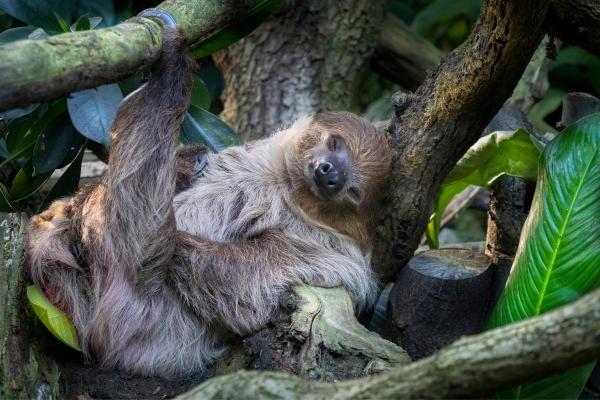How Much Does a Sloth Sleep?


Sloths are known for their slow movement, often looking sleepy even when most active. This is not the same as being asleep and they will need different periods of rest and activity depending on various factors. Sloths belong to the order Pilosa, an order of mammals that also includes anteaters. Sloths are divided into two families of three-toed sloths (Bradypodidae) and two-toed sloths (Mylodontoidea). Both families share notable characteristics, such as their herbivorous diet, bodies adapted for life in trees and their famous slowness of movement.
In this AnimalWised article, we ask how much does a sloth sleep? We look at how sloth sleeping habits can help them to maximize their chances of survival in the often dangerous tropical forests which make up their natural habitat.
How much does a sloth sleep a day?
Sloths are famous for their calm and relaxed lifestyle, but this doesn't mean they are asleep all the time. They still need to carry out necessary behaviors such as eating and reproducing. Generally speaking, sloths can sleep between 15 to 18 hours a day. The factors which determine this amount are the following:
- Age
- State of health
- Activity levels
- Environment in which they live
Sloths are nocturnal and crepuscular animals, meaning they are most active at night and at twilight. Their greatest periods of rest tend to be during the day. This is partly due to their diet which consists of mostly leaves. Foliage is difficult to digest and provides little energy, forcing them to rest and conserve their energy to carry out other behaviors.
If you are wondering how much a sloth sleeps a day depending on the type, we can look at the following sloth sleeping habits according to examples from each family:
- Three-toed sloths: one of the most common is the brown-throated sloth (Bradypus variegatus) which tends to sleep slightly more than two-toed sloths, with averages ranging from 15 to 20 hours a day.
- Two-toed sloths: an example can be seen in the Linnaeus's two-toed sloth (Choloepus didactylus) which typically sleep between 10 and 14 hours a day. These differences can be attributed to the different survival strategies and foraging behaviors of each species.
It is important to note that sloth sleep is not continuous, but is fragmented into short periods of deep sleep interspersed with moments of light sleep. This is due to their need to be alert to possible predators and their adaptation to living in an environment where safety is crucial for survival.
Although sloths are perhaps most noted for their slowness, they are not the only sleepy animal. Learn more with our guide to the animals that sleep the most.

Sloth sleep cycle
To discover more about sloth sleeping habits, we can look at their sleep cycle in detail. Sloths have a very peculiar sleeping pattern adapted to their arboreal lifestyle and slow metabolism. Although research on this topic is still ongoing, several research projects and observations have been conducted that offer a clearer view of how sloths sleep.
These animals exhibit a highly fragmented sleep cycle with multiple episodes of both light and deep sleep throughout the day and night. This is known as polyphasic sleep. These sleep episodes can last between 1 and 10 minutes, although some can be hours at a time. Sloths often wake up briefly in between rest periods.
Some studies have used electroencephalography techniques to investigate brain activity during sleep in sloths. These studies have revealed characteristic patterns of REM and non-REM sleep, similar to those observed in other mammalian animals. Despite similarity, they can differ slightly.
The sleep cycle of sloths is closely related to their arboreal habitat. They spend most of their lives in the treetops where they can find security from terrestrial predators. Their ability to sleep hanging upside down from branches has been adapted to minimize the muscular effort required to support themselves.
In addition to remaining still for security purposes, it aids their slow metabolism. Since their diet is mainly made of leaves and similar plant material, remaining inactive helps to channel more energy to their digestion. Additionally, deep sleep can help them minimize heat loss on cold rainforest nights.
Several environmental and biological factors can influence the sleep cycle of sloths, including:
- Availability of food
- Ambient temperature
- Age
- State of health of the animal
- Presence of predators
Predator presence is a very important factor in sloth behavior. Although most cloths are nocturnal, individuals can change their sleeping habits if there is a greater presence of predators during the night.

How do sloths sleep?
In addition to how much sloths sleep a day and their overall sleep cycle, we can look at how sloths physically sleep. Sloths have a unique method of sleeping that is adapted to their arboreal lifestyle. They often sleep hanging upside down from tree branches. They cling to these branches with their sharp claws and suspend themselves with the help of their specialized musculoskeletal system.
This position allows them to rest while minimizing the muscular effort required to stay in place. Some sloths may sleep curled up in a ball. Their front and hind limbs are together and their head is tucked between them. This sloth sleeping posture allows them to minimize their profile and protect their vital organs while they rest.
Others may sleep stretched out completely along a branch, with their limbs extended outward and their head resting on their chest or in a slightly inclined position. This sleeping posture provides them comfort and support while they rest.
Sloths may occasionally sleep with their heads up, supporting their body with their limbs and resting their heads on their chest or in an elevated position. This posture may be less common and is usually observed during times of complete relaxation.
Sloths are known for their incredible flexibility, allowing them to adopt such a wide variety of sleeping positions. They often wake up briefly between sleep periods which allows them to be alert to possible threats in their environment. When these threats present themselves, the sloth may adopt different postures to rest.
Now that you know how much a sloth sleeps a day, you may want to know more about these beautiful animals with our articles on interesting facts about sloths and what do sloths eat?
If you want to read similar articles to How Much Does a Sloth Sleep?, we recommend you visit our Facts about the animal kingdom category.
- Giné, G. A. F., Cassano, C. R., de Almeida, S. S., & Faria, D. (2015). Activity budget, pattern and rhythm of manned sloths (Bradypus torquatus): responses to variations in ambient temperature. Mammalian Biology, 80, 459-467.
- Oliveira Bezerra, D. D., de Lucena, L. R. R., Duffield, G. E., Acri, D. J., & Pontes, A. R. M. (2020). Activity pattern, budget and diurnal rhythmicity of the brown-throated three-toed sloth (Bradypus variegatus) in northeastern Brazil . Mammalian Biology, 100(4), 337-353.
- Urbani, B., & Bosque, C. (2007). Feeding ecology and postural behavior of the three-toed sloth (Bradypus variegatus flaccidus) in northern Venezuela. Mammalian Biology, 72(6), 321-329.
- Voirin, B., Scriba, M. F., Martinez-Gonzalez, D., Vyssotski, A. L., Wikelski, M., & Rattenborg, N. C. (2014). Ecology and neurophysiology of sleep in two wild sloth species. Sleep, 37(4), 753-761.







